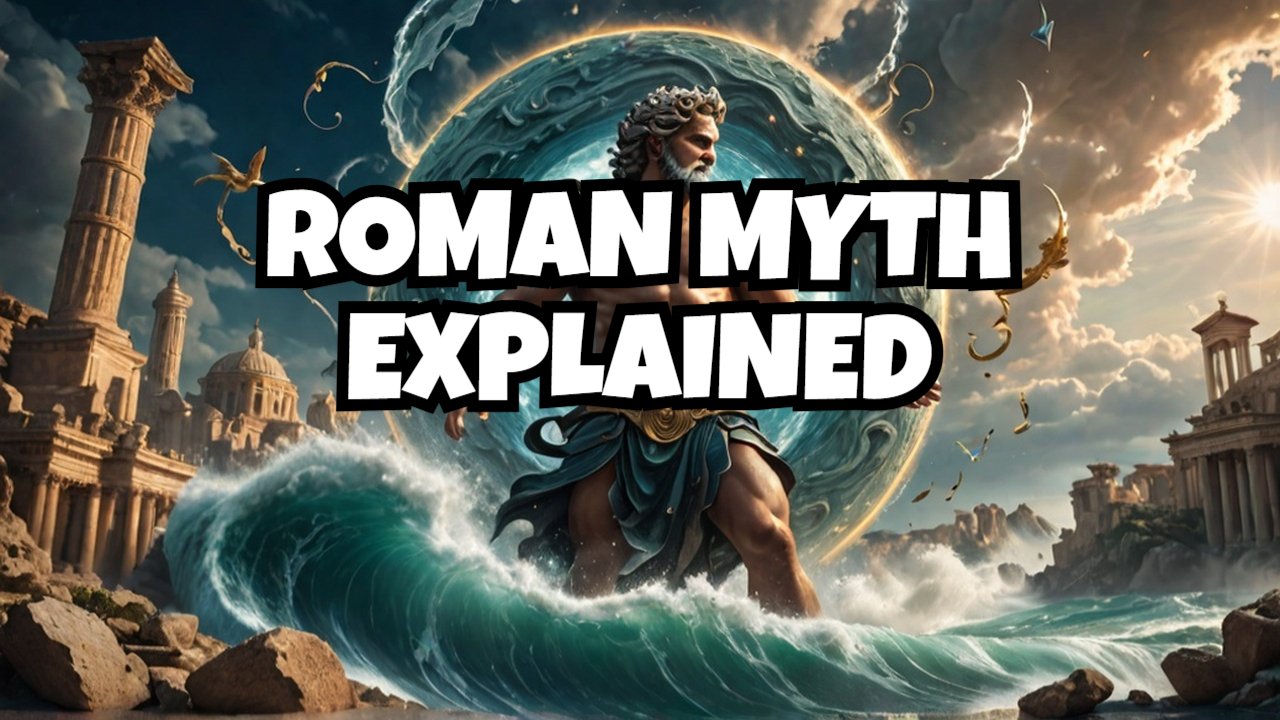Before there was an empire, before there were legions, and way before two twin brothers were famously raised by a wolf, the universe was… nothing. Just a formless, featureless void. From this chaos, a god would rise who did something truly unthinkable to hold onto his power: he ate his own children.
Now, this isn’t just some grim fairy tale. This is the official beginning of a story that ends with Rome conquering the known world. It’s a saga of cosmic war, divine paranoia, and a sibling rivalry so intense it would literally build a city.
Ever wonder how the Romans a civilization famous for its brutal efficiency, its laws, and its engineering explained where they came from? Their answer was a story soaked in violence, driven by prophecy, and born from a desperate need to create order out of complete madness. So, how do you get from a cannibal god to the gleaming marble of the Roman Forum? The journey is one of the most epic in all of mythology.
In the beginning, there was no sun, no moon, no land, and no sea. There was only Chaos. Try to picture it: a shapeless, jumbled mess. A swirling soup where hot was fighting cold, wet was at war with dry, and everything was tangled together in a pointless, endless conflict. It was a universe without form, a silent, dark abyss that was somehow everything and nothing all at once.
Then, out of this primordial sludge, a creative force a kind of unnamed cosmic architect stepped in to clean up the mess. The Roman poet Ovid, who wrote down many of these myths, described it as a grand act of organization. This creator began to untangle the universe. He pushed the fiery, weightless heavens up to the highest point and let the heavy earth settle below. He separated the waters to reveal dry land, carving out coastlines and riverbeds. He told the winds where to go so they wouldn’t tear the new world apart. The earth was finally shaped into a great sphere, and for the first time, the stars, which had been hiding in the darkness, could finally ignite the sky.
This wasn’t creation out of thin air. It was more like the ultimate decluttering project. The raw, warring elements of the universe were finally given a purpose and a place, creating a cosmos where harmony was possible. Order had finally been brought to the void. But the age of the gods was about to begin, and it was going to be anything but peaceful.
As the world took its new shape, the first generation of gods appeared: the Titans. The top dog among them was Saturn, the god of time and agriculture. Now, if this is starting to sound familiar, you’re not wrong. The Romans famously borrowed and adapted a lot of their mythology from the Greeks, and Saturn is their version of the Greek Titan, Cronus. And just like Cronus, Saturn was haunted by a terrifying prophecy.
He was told that one of his own sons would eventually overthrow him, just as he had overthrown his own father. Absolutely gripped by paranoia, Saturn came up with a monstrous plan: every time his wife, Ops, gave birth, he would swallow the child whole. Vesta, Ceres, Juno, Pluto, and Neptune were all born, and one by one, their father ate them.
But Ops was determined to save her last child. When she gave birth to a son, Jupiter, she secretly whisked the infant away to the island of Crete. To trick her husband, she wrapped a big rock in swaddling clothes and handed it to Saturn. Blinded by fear, he swallowed the stone without even looking, thinking he’d finally secured his throne.
Of course, Jupiter grew up in secret, getting stronger and smarter. When he was ready, he came back and confronted his father, forcing him to regurgitate his siblings, who were, amazingly, still alive and whole inside him. Together, Jupiter and his brothers and sisters declared war on Saturn and the Titans. The new generation the Olympians won the war. And Jupiter, the baby who escaped being a meal, became the new king of the gods, fulfilling the very prophecy his father had tried so desperately to avoid.
But here’s where the Romans add their own unique twist. Defeated, Saturn didn’t just disappear. He fled to Italy, where he was welcomed by the two-faced god, Janus. In Italy, Saturn’s reign wasn’t one of terror. It was remembered as a Golden Age—a mythical era of perfect happiness, endless food, and total peace, where humans lived without work or war. This part of the story is distinctly Roman, planting their creation myth right in the soil of Italy itself.
So, the gods are in charge, and humanity is living below. But for the Romans, a divine creation story wasn’t quite enough. They needed a heroic origin, a link to the legends of the past. To get it, they looked to the smoking ruins of the greatest city of the heroic age: Troy.
Their story continues with Aeneas, a Trojan hero and, not coincidentally, the son of the goddess Venus. When the Greeks sacked Troy, Aeneas escaped the burning city, chosen by the gods for a grand destiny. He led a band of survivors on a long, brutal journey across the Mediterranean, all in search of a new home. This quest, written down in Virgil’s epic poem, the Aeneid, finally brought him to the shores of Italy.
There, after a whole lot more fighting, Aeneas became the forefather of the Latin people. His descendants went on to found the city of Alba Longa, a kingdom that ruled the area for generations. This link was a stroke of genius for Roman PR. It gave them a direct bloodline to the famous Trojan heroes and a divine ancestor in Venus. Suddenly, they weren’t just some local tribe. They were the heirs of a legendary civilization, destined to build something even greater.
Generations after Aeneas, the king of Alba Longa was a man named Numitor. But his cruel and ambitious brother, Amulius, stole the throne. To make sure no one could challenge him, Amulius killed Numitor’s sons and forced his daughter, Rhea Silvia, to become a Vestal Virgin a priestess sworn to celibacy. No kids, no rivals.
But the gods had other ideas. The war god, Mars, paid a visit to Rhea Silvia, and she gave birth to twin boys: Romulus and Remus. When King Amulius found out, he was furious. Terrified the boys would grow up to avenge their grandfather, he ordered them thrown into the Tiber River to drown.
The servants, however, saw the river was flooding. So they just left the basket with the twins in the shallow waters at the river’s edge, figuring it would do the job. But the basket floated safely downstream until it came to rest at the base of a hill. And what happened next became the most iconic image in all of Roman history. A she-wolf, coming down from the hills for a drink, heard the babies crying. Instead of attacking them, she nursed them as if they were her own pups.
Later, a shepherd named Faustulus found the boys and raised them as his own. Romulus and Remus grew up to be brave and natural leaders, completely unaware of their royal blood—though their noble character was a pretty big hint.
This entire story, from chaos to a wolf-mother, is the bedrock of Roman identity. If you’re loving this journey through mythology, do us a favor and hit that subscribe button. Ring the bell, too, so you don’t miss our next deep dive into the ancient world.
As young men, Romulus and Remus finally learned the truth about who they were. Fueled by a sense of justice, they marched on Alba Longa, kicked out the tyrant Amulius, and put their grandfather Numitor back on his throne.
But they weren’t meant to just be princes. They were builders. They decided to found their own city right near the spot where the she-wolf had saved them. And this is where the story takes its final, tragic turn. The two brothers, who had survived a death sentence and been raised by a wolf together, couldn’t agree on how to build their city.
A bitter fight started over the location. Romulus wanted to build on the Palatine Hill, but Remus preferred the Aventine Hill. To settle it, they turned to the gods and performed an augury basically, birdwatching for divine omens. Remus saw the first sign: six vultures. He claimed victory. But just moments later, Romulus saw a flock of twelve vultures. He argued his sign was bigger and therefore better.
The argument exploded into a brawl between their followers, and in the chaos, Remus was killed. Another, more personal version of the story says that Romulus started building his city walls on the Palatine Hill. Remus, to mock how short and weak they were, contemptuously jumped over them. Enraged at the insult and the violation of his sacred new city, Romulus struck his brother down, shouting, “So shall it be for anyone else who ever leaps over my walls!”
The foundation of Rome was sealed in a brother’s blood. With Remus dead, Romulus became the city’s first king and sole founder. He named it Rome, after himself.
So, from a swirling, formless Chaos, a world was made. From a paranoid god who ate his children, a new divine order was born. From the ashes of Troy, a heroic destiny was forged. But in the end, the Eternal City of Rome was founded on murder, a brother killing a brother.
This epic, brutal, and divine story was everything to the Romans. It was their identity. It explained their unshakeable belief in fate, their personal connection to the gods, and the deep-seated idea that their city was born from both divine will and human conflict. The tale of Romulus and Remus a story of survival, ambition, and fratricide became the foundational myth for a civilization that would rise from a single hill to rule the world, forever shaped by the violent and chaotic legacy of its own creation.





